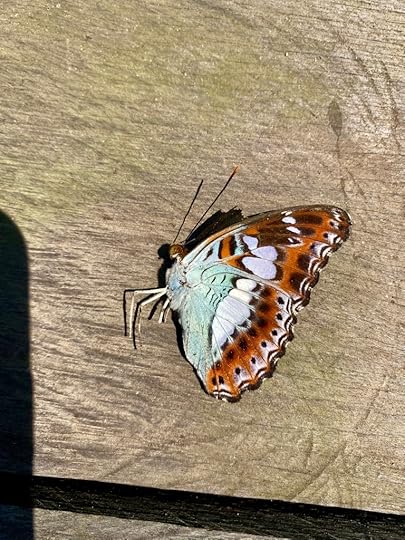Against time we stand defeated
The other morning, I noticed that a large cocoon, which had been stuck to our bathroom wall for some time, was empty; the brand-new butterfly had emerged.
Such are the cycles of nature: flora and fauna change, decay, and perish. The beauty and magic of nature lie in these transformations and in decay. The shifting light of the sky, thunderclouds that drift in to darken everything, rainbows that briefly create colorful streaks above ground, fog that dissipates, and rain that thickens. All heralding the arrival of autumn and remind us of nature’s ebb and flow. The fruit that is at its ripest and most aromatic is often teetering on the brink of rot, while the fragrant scent of hyacinths culminates just before they wither. Leaves decay, turning into soil and nourishment for other plants while bubbling spring buds herald new beginnings.
These are the motifs that inspire still-life and landscape painters alike.
Why?
Because change offers the possibility of seeing and understanding; contrasts and contradictions are prerequisites for insight and wisdom — and within decay lies the seed for something new.

However, decay and perishability are not exactly favored themes in the lives of cultivated modern humans. These aspects of life are often resisted and denied, polished and smoothed over. The prevailing consensus seems to be that the ravages of time are disfiguring.
Yet against time, we ultimately stand defeated. By insisting on immutability and smoothness, we act against one of the most liberating truths: everything is always changing.
The only constant in human life is change. I choose to see this as liberating because it embodies dynamism and vitality. It stands in stark contrast to stagnation and immobility. While there’s nothing inherently wrong with a certain degree of stillness or grounding in one’s life, clinging convulsively to the status quo — believing that everything remaining the same equates to balance and harmony — risks overlooking the freeing beauty of allowing oneself to float along the currents of life, openly and freely. Moreover, it often leads to a disregard for the beauty of the raw and weathered, the enhancing traces of use on beloved objects, and the rhythms of blooming and withering in nature.
Decay is intensely detested by the cultivated modern human being, as it is often linked to aging. Being old seems to be something to be embarrassed about. But being old is not a disease. I feel grateful each year for having survived another cycle on this planet, and for experiencing another year filled with joy, disappointments, hardships, aesthetic pleasures, knowledge, love, friendships, and sensual experiences.
Some of my friends, particularly my female friends, feel embarrassed to talk about their age. I can feel the discomfort myself when asked about it — along with the joy of responses like, “No way! Are you really that old? You don’t look it!” This seems to be the ultimate compliment for women today. It’s as if our value decreases with age — just like trendy, smooth, flashy products lose their allure. Women aren’t allowed to age. It’s a strange situation.
Being a woman over 40, or 50, or even worse, over 60 or 70, is treated as something to be hidden away, smoothed over, or lied about. Only if you appear to defy age — typically through plastic surgery, Botox, or rigorous exercise — can you find some measure of pride in looking youthful.

This phenomenon brings to mind the concept of graywashing, which echoes the idea of greenwashing, where brands make superficial gestures toward inclusivity without addressing the deeper issue. In this case, graywashing occurs when companies use older models with gray hair or wrinkles to create an illusion of embracing aging — while still clinging to a youth-centered beauty standard. It’s like saying, “Aging is acceptable, but only if you don’t really look your age.”
The problem with graywashing is that it doesn’t truly challenge our culture’s obsession with youth. Instead, it reinforces the notion that aging is only admirable if it’s polished, curated, and hidden as much as possible. It’s still about trying to appear youthful rather than genuinely celebrating the natural process of growing older.
True change would mean embracing age for what it is — celebrating wrinkles as marks of experience, seeing gray hair as a sign of wisdom, and valuing people for their depth and insight, not just for how well they can conceal the signs of aging. Graywashing, like greenwashing, is surface-level change. What we really need is a shift in how we perceive beauty and worth, one that honors the richness of life at every stage, without the need to smooth out or hide the passage of time.
Do we really want to live in a world where eternal youth is the norm and where eliminating the natural traces of time is seen as an achievement? There’s nothing more life-denying!
Nothing is more life-denying than fighting against the law of life: everything is on the way, and not in its final form. — Daniel Quinn
This statement from the imfamous eco-author Daniel Quinn’s thought-provoking book The Story of B holds profound wisdom that appears to have been forgotten in the predominant culture of our era.
“Everything is on its way, not in its final form.” This is the law of life. As much as we may view our culture as the most evolved and accomplished in human history, it is, paradoxically, the most stagnant that has ever existed — thus the most life-denying and rigid, the most unsustainable.
Why is that?
Because it goes against the fundamental principles of life: the idea that everything is always evolving and that that is where true beauty lies.



